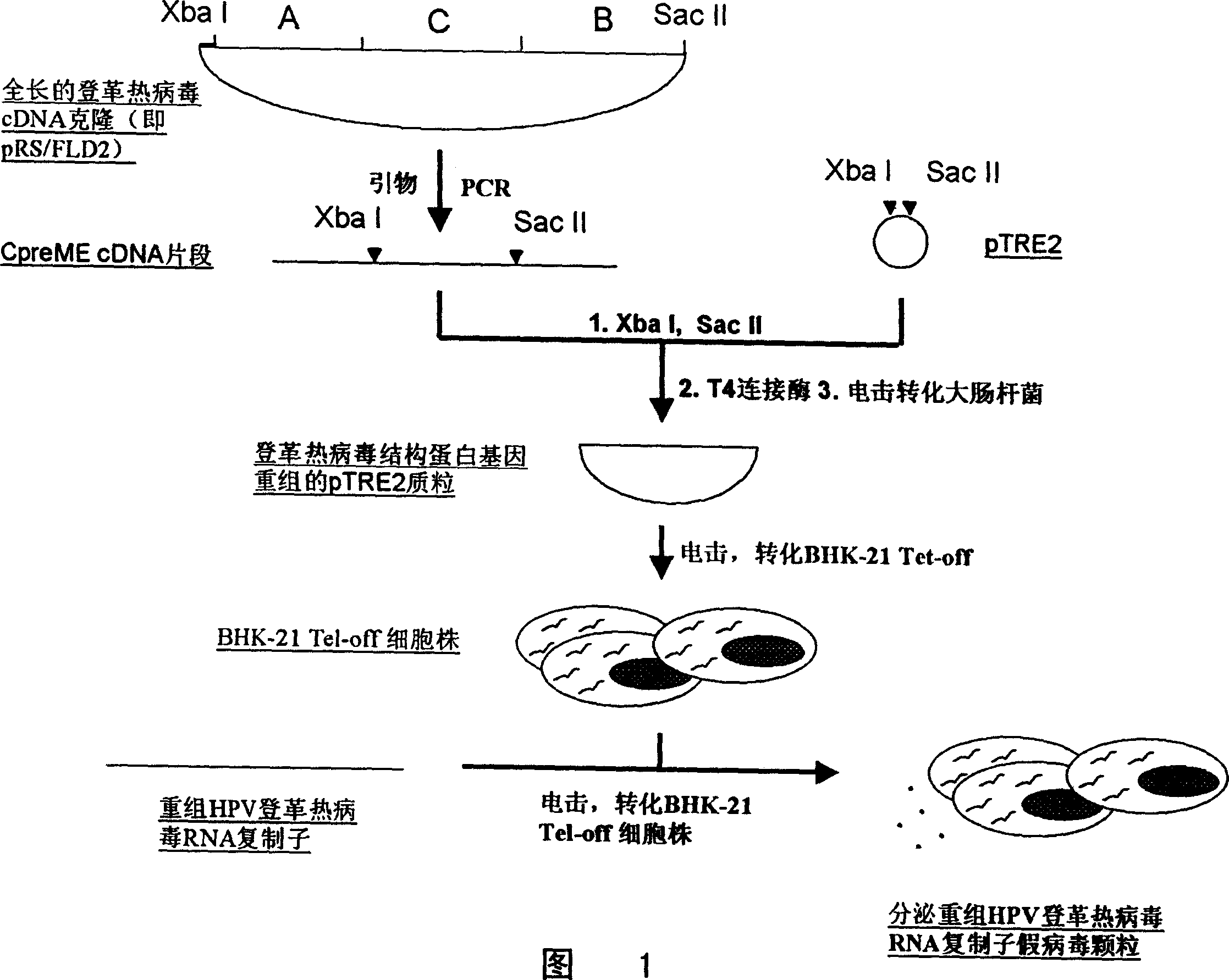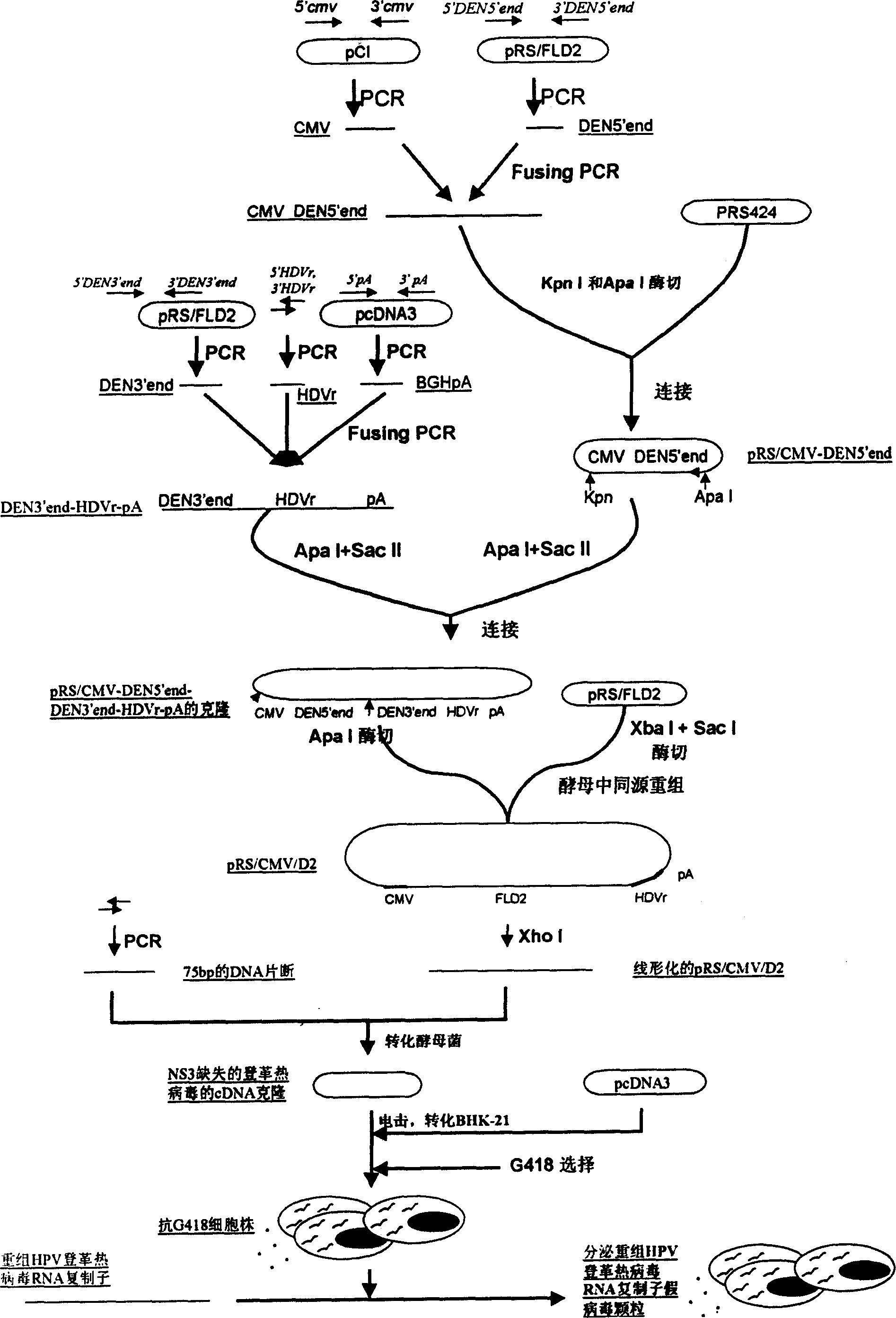Vaccine for human papiloma virus
A technology of dengue virus and pseudovirion particles, applied in the field of dengue virus, can solve the problems of low success rate of dendritic cell expansion and activation, time-consuming and laborious, difficult to achieve quality control, etc.
- Summary
- Abstract
- Description
- Claims
- Application Information
AI Technical Summary
Problems solved by technology
Method used
Image
Examples
Embodiment 1
[0099] Preparation process of full-length dengue virus cDNA clone
[0100] 1. Integrate the full-length dengue virus cDNA into the pRS424 plasmid (Plasmid) to prepare a full-length dengue virus cDNA clone. The dengue virus type II NGC (ATCC #: VR-1255) and pRS424 plasmid (ATCC #: 77105) were purchased from the American Type Culture Collection (ATCC).
[0101] a) Dengue virus RNA is converted into three segments of dengue virus cDNA fragments (5' end cDNA, 3' end cDNA and middle segment cDNA) by RT-PCR method, and Xba I is added to the 5' end of the 5' end cDNA fragment Restriction site and Sp6 enhancer sequence; Sac I enzyme site is added to the 3' end of the 3' end fragment; the two ends of the middle fragment include part of the 3' end and 3' end cDNA fragment of the 5' end cDNA fragment The same gene sequence at the 5' end.
[0102] Primer
Sequence (5'-3')
SEQ ID NO:
1a.
TGCACATTCGCTCTAGAATTTAGGTGACACTATAGAGTTGTTAGTCTACGTGGACC
6
...
Embodiment 2
[0111] Preparation of HPV E7-E6-2A DNA Fragment
[0112] (i) wherein the E7-E6 sequence is an HPV oncogene (Gene Bank accession numbers: AF486352; AF469197; AF472508), as shown in SEQ ID NO: 1, encoding a 256 amino acid antigen (SEQ ID NO: 2).
[0113] (ii) The 2A is a gene fragment of foot-and-mouth disease virus, consisting of 60 bases, and its gene sequence is shown in SEQ ID NO: 3 in the sequence table.
[0114](iii) Using the HPV-16 plasmid (ATCC#: 45113D) as a template, using GCGAGAAATACGCCTTTCAATATGCTGAAACGCGAGAGAAACATGCATGGAGATACACCTACA (SEQ ID NO: 12) and TGCAGTTCTCTTTTGGTGCATTGGTTTCTGAGAACAGATGGG (SEQ ID NO: 13) as a pair of primers respectively; and using ATGCACCAAAAGAGAACTG AAGGTCAAAAATTCAACAGCTGGGTTTCTCTACGTGT (SEQ ID NO: 15) was used as another pair of primers to prepare E6 and E7 cDNA fragments by PCR. The 21nt of the 5' end of the E6 cDNA fragment is identical to the partial sequence of the 3' end of the E7 cDNA fragment, the 21nt of the 3' end of the E6 cDNA ...
Embodiment 3
[0117] The Process of Integrating HPV Viral Genes into Dengue Virus RNA Replicon
[0118] 1. The full-length dengue virus cDNA clone (abbreviated as pRS / FLD2) prepared in the first step c) of Example 1. Cut into lines with BamH I endonuclease.
[0119] 2. Transform the linear dengue fever virus cDNA clone (pRS / FLD2) and the HPV E7-E6-2A cDNA fragment together into yeast (yeast). During the DNA replication process of the yeast, the HPV E7-E6-2A cDNA fragment can Automatically integrated into the dengue virus cDNA clone, and replace the gene sequence of the dengue virus structural protein (including the C coding region sequence, the M coding region sequence and the E coding region sequence), to generate a large number of circular HPV-dengue fever virus RNA replicons cDNA clone (ie pRS / D2-HPV16).
[0120] 3. The cDNA clone of the HPV-dengue virus RNA replicon produced in step 2 was purified from yeast with Qiagencolumn (QIAGEN Inc.).
[0121] 4. Transformation of Stabl2 with c...
PUM
 Login to View More
Login to View More Abstract
Description
Claims
Application Information
 Login to View More
Login to View More - R&D
- Intellectual Property
- Life Sciences
- Materials
- Tech Scout
- Unparalleled Data Quality
- Higher Quality Content
- 60% Fewer Hallucinations
Browse by: Latest US Patents, China's latest patents, Technical Efficacy Thesaurus, Application Domain, Technology Topic, Popular Technical Reports.
© 2025 PatSnap. All rights reserved.Legal|Privacy policy|Modern Slavery Act Transparency Statement|Sitemap|About US| Contact US: help@patsnap.com


